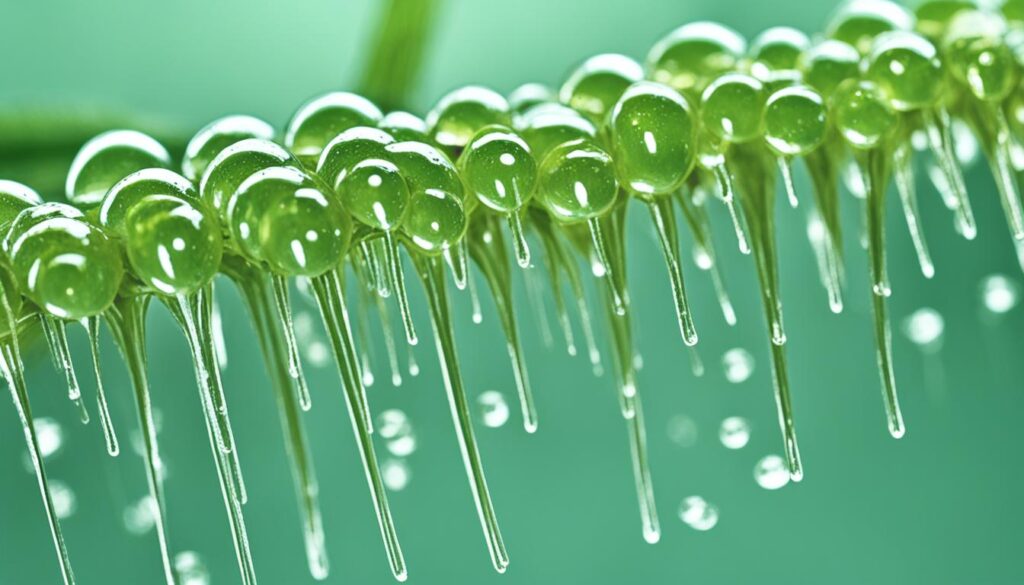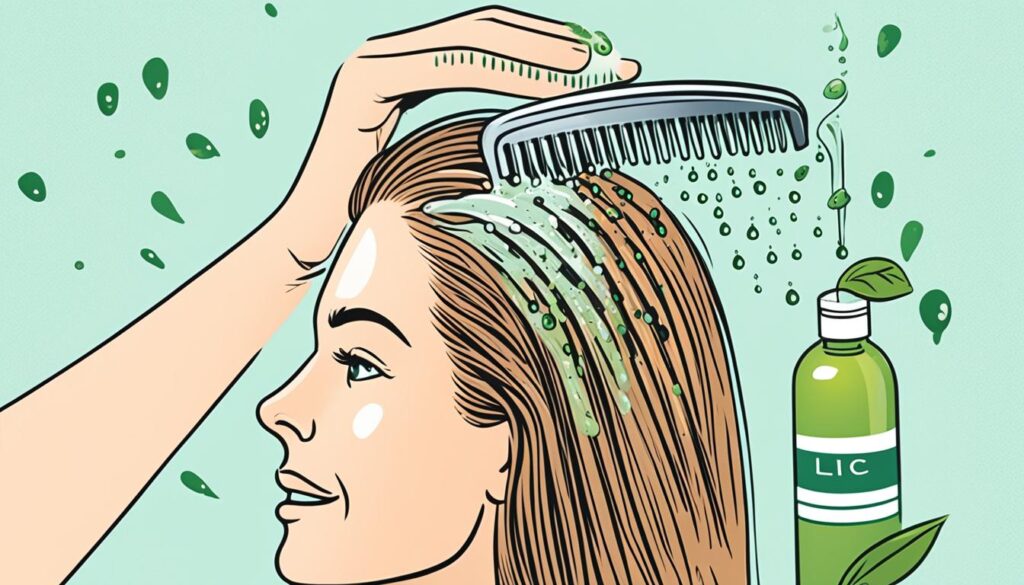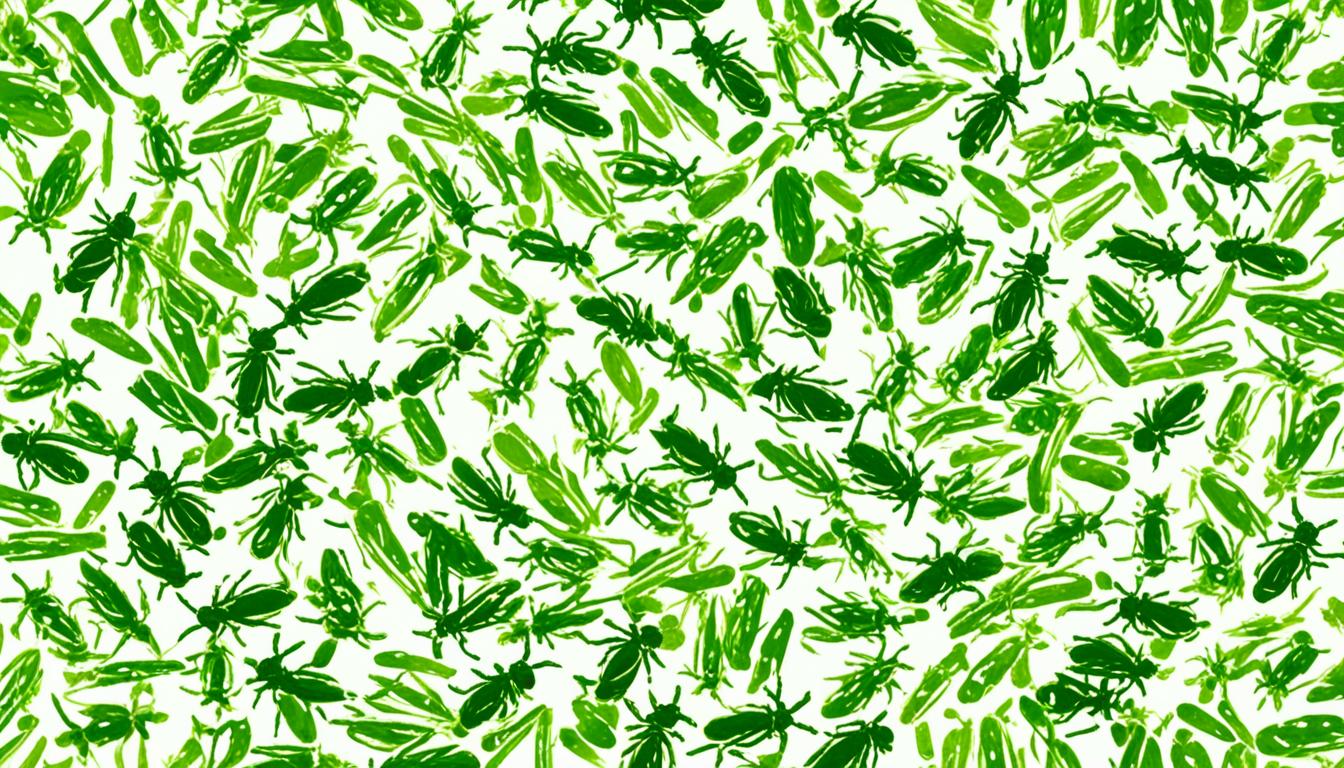“As an Amazon Associate I earn from qualifying purchases.” .
The mention of lice often makes us scratch our heads. These tiny pests are a big problem, leading to annoyance and embarrassment. Many seek relief in nature, using tea tree oil, an ancient remedy. People wonder if tea tree oil can actually kill lice or if it’s just a myth.
For those battling lice, tea tree oil is a beacon of hope. Behind each bottle and comb is a story. It’s a mix of the sweet scent of the oil and the fight against lice. Let’s see how this old remedy does against lice today.
Key Takeaways
- Tea tree oil has a storied history with antiseptic properties that may offer hope against lice infestations.
- Scientific curiosity piques at the potential of tea tree oil as a lice-eliminating treatment, necessitating more research for conclusive evidence.
- Correct usage and dilution are crucial for any tea tree oil lice treatment, ensuring safety and striving for maximum efficacy.
- The potential of tea tree oil to prevent and disrupt the life cycle of lice inspires natural remedy enthusiasts.
- Understanding the balance of tradition and science may be key to utilizing tea tree oil in our modern fight against lice.
Introduction to the Power of Tea Tree Oil
The power of tea tree oil is ancient wisdom in action. It comes from the leaves of the Melaleuca alternifolia plant. This oil is known for fighting skin issues and even respiratory infections.
Now, let’s talk about when things get a little ‘buggy’. Yes, we mean lice that make homes in our hair. The benefits of tea tree oil for lice are well-known. It kills lice and stops their feast on our scalps.
Before, fighting lice meant using strong chemicals. But tea tree oil offers a gentle, effective solution. It’s a natural fighter against lice and is becoming more popular.
- Potent antimicrobial properties
- Efficiency in terminating lice
- Prevention of lice feeding and reproduction
- Natural substitution for chemical treatments
Using tea tree oil shows how versatile it is against lice. It’s a top choice for those seeking natural remedies. Let’s celebrate being lice-free with tea tree oil!
Does Tea Tree Oil Kill Lice?
Trying to get rid of lice? Tea tree oil could be your solution. It’s hailed as a natural fix in fighting lice. But can old remedies withstand modern science? Let’s explore the evidence and important facts about using this fragrant oil against lice.
The Science Behind Tea Tree Oil as a Lice Treatment
While final scientific conclusions are pending, current research offers hope. Studies show tea tree oil’s components, like terpinen-4-ol, have strong antimicrobial effects. These components kill lice at various life stages and prevent their growth. It’s an effective way to tackle the problem on two fronts.
Concentration and Timing: Key Factors in Lice Eradication
For tea tree oil to work, the concentration and timing must be right. Using too little means ineffective treatment; too much is overkill. Aim for a 1-2% tea tree oil mixture. Applying this mix and leaving it on for the right time is crucial for success. It’s about giving your scalp enough time to absorb the oil’s benefits.
As research progresses, we’ll learn more about tea tree oil and lice. The natural approach seems promising for now. It shows that nature’s cupboard might have what we need to fight lice.
How to Use Tea Tree Oil for Lice
Learning how to use tea tree oil for lice can change how you tackle this issue. Tea tree oil is famous as a natural remedy for lice. Dive into how to use this oil for a lice-free scalp.
Start your battle against lice by understanding tea tree oil’s strength. Mix it with coconut or olive oil to dilute. This mix makes a scalp treatment that’s safe and effective.
Put this mix on your scalp softly, making sure it covers well. Leave it on for at least 30 minutes to work best. Overnight works best for tough cases.
Next, use a fine-toothed comb on your hair to get rid of lice and nits. You will need to do this treatment several times. Doing so regularly helps beat the infestation.
Here’s a simple table to guide you through the tea tree oil lice treatment:
| Steps | Description | Duration | Frequency |
|---|---|---|---|
| Dilution | Mix tea tree oil with a carrier oil | N/A | Each application |
| Application | Massage into the scalp thoroughly | 30 mins to overnight | Start of treatment |
| Comb through | Use fine-toothed comb to remove lice/nits | Varies | After each application |
| Repeat | Reapply oil mixture and comb out pests | Every few days | Until infestation is gone |
In the end, tea tree oil stands out as a perfect lice fighter. Stick to this plan, and you’ll be free from lice. Embrace this fragrant solution and win.
Tea Tree Oil and Lice Prevention: What Research Shows
Parents and people are looking for natural ways to deal with lice. Tea tree oil is often talked about for this. It has shown promise in keeping lice away. Let’s delve into the research to uncover the truth.
Studies on Tea Tree Oil’s Repellent Efficacy
When it comes to lice, preventing them is usually easier than treating them. Recent research has focused on tea tree oil as a way to keep lice away. Tea tree oil has a strong smell that lice don’t like. So, using it regularly might help keep lice away.
The Impact of Tea Tree Oil on Lice Egg Hatching
Lice eggs are tough, but tea tree oil might be a game-changer. There’s evidence that tea tree oil could stop these eggs from hatching. We need more research to be sure, but it looks promising for natural lice prevention.

There are positive signs that tea tree oil works against lice. But experts say we need more thorough studies. They want to create clear guidelines based on solid science. As we explore further, nature’s solution to lice might just be tea tree oil.
Contemporary Tea Tree Oil Products for Lice Removal
Dealing with lice just got easier thanks to tea tree oil lice removal products. Today’s market is filled with contemporary tea tree oil lice treatments. They range from shampoos and conditioners to sprays. These products not only fight off lice but keep them from coming back.
Here’s why these products are top picks for battling lice:
- They’re effective and easy to use. The blend of tea tree oil with other natural ingredients works well. The different forms they come in add to the convenience.
- Quality is key. For best results, choose products with high-quality, pure tea tree oil.
- Following instructions boosts the chance of getting rid of lice. So, always read the label.
These modern solutions use nature to keep lice away. Next time you’re looking for a remedy, choose tea tree oil lice treatments. They could just be your answer to a lice-free life.
Benefits of Tea Tree Oil for Lice Compared to Traditional Treatments
Tea tree oil stands out when we talk about getting rid of lice. It’s a natural option compared to traditional treatments that use harsh chemicals. Many prefer tea tree oil because it avoids the negative environmental impact and skin irritation common with chemical treatments.

Understanding the Advantages Over Chemical Pediculicides
Chemical pediculicides may work at first, but lice can become resistant. Tea tree oil, on the other hand, is effective at killing lice and preventing them from becoming resistant. It disrupts the lice’s survival strategies effectively.
Unlike synthetics, tea tree oil’s complex compound cocktail is tougher for lice to grow resistant to, marking it a significant ally in the ongoing tug-of-war between humans and lice.
Addressing Resistances: Tea Tree Oil as a Natural Alternative
The benefits of tea tree oil go beyond just killing lice. It also helps heal the scalp with its antimicrobial and anti-inflammatory properties. Choosing tea tree oil means not only solving the lice problem but also caring for your scalp’s health.
| Feature | Chemical Pediculicides | Tea Tree Oil |
|---|---|---|
| Active Ingredients | Synthetic chemicals | Natural terpinen-4-ol |
| Resistance Potential | Higher possibility of resistance | Lower likelihood of resistance development |
| Scalp Health Impact | Potential irritation and drying | Antimicrobial, soothing effects |
| Environmental Impact | Chemical runoff potential | Eco-friendly, biodegradable |
Choosing tea tree oil for lice treatment is a smart move. It offers multiple benefits, from effectively dealing with lice to caring for your scalp and the environment. This natural solution might just give your scalp the refreshment it needs after dealing with lice.
The Potential Risks of Using Tea Tree Oil on the Scalp
Tea tree oil is praised for fighting lice thanks to its natural pesticidal properties. But let’s pause—before drenching your scalp in this aromatic essence, it’s critical to discuss the risks of using tea tree oil on scalp and potential side effects of tea tree oil. After all, even heroes have their flaws.
Imagine wanting to naturally fight off lice. You use tea tree oil, known for its healing powers and potential scalp irritation. In fact, for some, this powerful oil can become a foe, causing dryness or irritation. This is especially true if you apply it too generously, like an eager gardener in spring.
The saying “dilution is the solution” is especially true for tea tree oil. It’s not a “splash it on and hope for the best” solution. The risks of using tea tree oil on scalp increase with undiluted or excessive use. So, a patch test becomes essential to keep your scalp from becoming an itchy mess.
Sometimes, healing agents can cause harm. This holds true when people have allergic reactions to tea tree oil. They might experience redness, itching, and swelling. It’s like rolling out the red carpet for side effects nobody wants.
- Dryness and Irritation
- Allergic Reactions
- Redness and Itching
- Swelling of the Scalp
| Side Effect | Description | Precautionary Measures |
|---|---|---|
| Dry and Irritated Scalp | A common annoyance, often from too much product. | Dilute with a carrier oil and perform a patch test. |
| Allergic Reactions | Shows up as redness, itching, or swelling. | Stop using it immediately and see a doctor. |
| Intense Itching | Itching indicates you might be sensitive to it. | Look for other options and consult your dermatologist. |
If you notice any potential side effects of tea tree oil, stop using it. Then, get help from healthcare professionals experienced in allergies. Remember, when fighting lice, it’s vital to protect not just your hair but also your scalp and your sense of humor.
Tea Tree Oil Lice Treatments: A User Guide
Welcome to the definitive tea tree oil lice treatment guide. In this guide, we will cover how to apply tea tree oil and mix it with other natural ingredients. This combination creates a powerful defense against lice. Let’s dive in!

Effective Application Techniques for Maximum Results
To effectively use tea tree oil for lice, be precise and patient. We’ve outlined steps to ensure effective use:
- Start by mixing tea tree oil with a carrier oil like coconut or olive.
- Apply the blend carefully, covering all areas of the scalp.
- Massage the mixture into the scalp, so it targets the lice and their eggs.
- Leave the oil on for some time, maybe even overnight with a shower cap on.
- Use a fine-toothed comb to remove the dead lice and nits then.
- Rinse well. Repeat this process for a week to get rid of all lice and nits.
Mixing Tea Tree Oil with Other Natural Substances for Enhanced Effect
Combining tea tree oil with other natural substances multiplies the power. It creates a stronger blend for fighting lice. Here’s a table showcasing some popular mix-ins:
| Natural Substance | Known Properties | How It Enhances Tea Tree Oil |
|---|---|---|
| Lavender Oil | Anti-inflammatory, soothing | Amplifies repellent qualities and adds a calming scent |
| Neem Oil | Anti-fungal, insecticidal | Boosts lice-fighting ability with extra repellent power |
| Peppermint Oil | Antimicrobial, cooling | Brings a cooling effect and a strong scent to deter lice |
| Eucalyptus Oil | Anti-inflammatory, decongestant | Increases the repellent effect with its sharp smell |
Before starting your blend, research each oil’s benefits and safety. Always do a patch test to avoid bad reactions. Now, you’re ready to mix your way to a lice-free life!
Experts’ Take on Tea Tree Oil’s Lice-Fighting Abilities
When talking about experts on tea tree oil for lice, views differ widely. It’s similar to exploring a market full of essential oils. Some are sure tea tree oil is effective against lice, highlighting its natural benefits in fighting head lice.
Many people trust its effectiveness, especially as part of a complete lice treatment plan. However, others caution, suggesting more studies are needed to truly understand its benefits.
So, what do the experts actually say? Let’s look at a comparison that might remind you of a science class table. But here, tea tree oil takes center stage:
| Expert Opinions | Recommended Practices | Research Notes |
|---|---|---|
| Supportive of tea tree oil use | Dilution with carrier oil | Effectively combats nymph and adult lice |
| Varying degrees of endorsement | Combine with thorough combing | Studies indicate interruption of lice lifecycle |
| Advocate for additional studies | Consult healthcare professionals | Research into long-term effectiveness needed |
In essence, not all experts agree about tea tree oil for lice, but many are optimistic. If you’re thinking about using tea tree oil, talk to a healthcare professional. They can offer tailored advice. Remember, the key is to use natural remedies with caution, informed by science and expert guidance.
Ready to lead your family’s lice treatment plan? Let’s find the right strategy!
Conclusion
In exploring tea tree oil’s power against lice, we’ve found important truths. Studies show tea tree oil’s effectiveness is based on real science, not just old stories. It’s proven to fight lice effectively, keeping them off our heads.
But we still need to learn more about how tea tree oil works on lice. More studies will help confirm its role in fighting lice. The conclusion on using tea tree oil for lice is like tasting a new tea. The first sip is good, but we’re waiting to discover its full potential.
Before trying tea tree oil, talk to a doctor or lice expert. They can guide you on how to use it safely. By doing this, tea tree oil can be safe and effective in getting rid of lice. Making sure it helps rather than harms is key for a lice-free head.
FAQ
Does tea tree oil kill lice?
How do I use tea tree oil for lice treatment?
What are the benefits of tea tree oil for lice compared to traditional treatments?
Are there any risks or side effects of using tea tree oil on the scalp?
How do I effectively use tea tree oil for lice treatment?
What do experts say about tea tree oil’s effectiveness against lice?
“As an Amazon Associate I earn from qualifying purchases.” .



